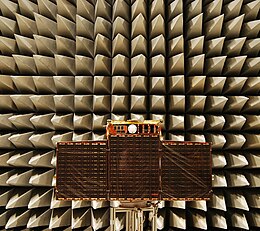| This article needs additional citations for verification. Please help improve this article by adding citations to reliable sources. Unsourced material may be challenged and removed. Find sources: "TET-1" – news · newspapers · books · scholar · JSTOR (July 2012) (Learn how and when to remove this message) |
 TET-1 undergoing testing TET-1 undergoing testing | |
| Mission type | Technology |
|---|---|
| Operator | DLR |
| COSPAR ID | 2012-039D |
| SATCAT no. | 38710 |
| Spacecraft properties | |
| Manufacturer | Kayser-Threde GmbH |
| Start of mission | |
| Launch date | 22 July 2012, 06:41 (2012-07-22UTC06:41Z) UTC |
| Rocket | Soyuz-FG/Fregat |
| Launch site | Baikonur 31/6 |
| End of mission | |
| Last contact | 17 November 2022 |
| Decay date | 18 November 2022 |
| Orbital parameters | |
| Reference system | Geocentric |
| Regime | Low Earth |
TET-1 (German: Technologieerprobungsträger 1, Technology Experiment Carrier) was a microsatellite operated by the German Space Operations Center of the German Aerospace Center. It was the centre of the OOV (On Orbit Verification) Program, initiated to offer on-orbit verification possibilities to the German industrial and scientific aerospace community. TET was based on the satellite bus used for the BIRD satellite, which was launched in 2001.
The main contractor for Phase A (feasibility) was IABG. The final contract for Phases B, C, and D (definition/qualification, and production) and start was given to Kayser-Threde GmbH, a medium-sized aerospace company based in Munich belonging to the German OHB-System group. The environmental qualification was successfully conducted in the IABG space simulation centre in Munich.
TET-1 was carried to orbit as a secondary payload on a Soyuz-FG/Fregat carrier rocket which was launched from the Baikonur Cosmodrome on 22 July 2012. The primary payload of the launch was the Kanopus-V1 satellite, with the BelKA-2, Zond-PP and exactView-1 satellites also flying on the same rocket.
After 10 years in orbit, the TET-1 satellite re-entered into the atmosphere on 18 November 2022.
References
- ^ Bergin, Chris (22 July 2012). "Russian Soyuz-FG successfully launches five satellites". NASASpaceflight.com. Retrieved 22 July 2012.
- "Das On-Orbit-Verifikations-Programm" [The On-Orbit-Verification-Program]. DLR Portal (in German). DLR. Retrieved 2022-11-24.
- "In-Orbit Verification". OHB. OHB-System AG. Retrieved 2022-11-23.
- "Abschied vom Technologie-Erprobungsträger (TET-1)" [Farewell to the technology test vehicle (TET-1)]. DLR Portal (in German). DLR. 2022-11-21. Retrieved 2022-11-23.
External links
- TET-1 information on DLR website
- TET-1 information on eoPortal website
- Kayser-Threde GmbH TET-1 logbook Archived 2010-11-22 at the Wayback Machine
- Brochure "TET - The Small Satellite" on OHB website
| ← 2011Orbital launches in 20122013 → | |
|---|---|
| January | |
| February | |
| March | |
| April | |
| May | |
| June | |
| July |
|
| August | |
| September | |
| October | |
| November | |
| December | |
| Launches are separated by dots ( • ), payloads by commas ( , ), multiple names for the same satellite by slashes ( / ). Crewed flights are underlined. Launch failures are marked with the † sign. Payloads deployed from other spacecraft are (enclosed in parentheses). | |